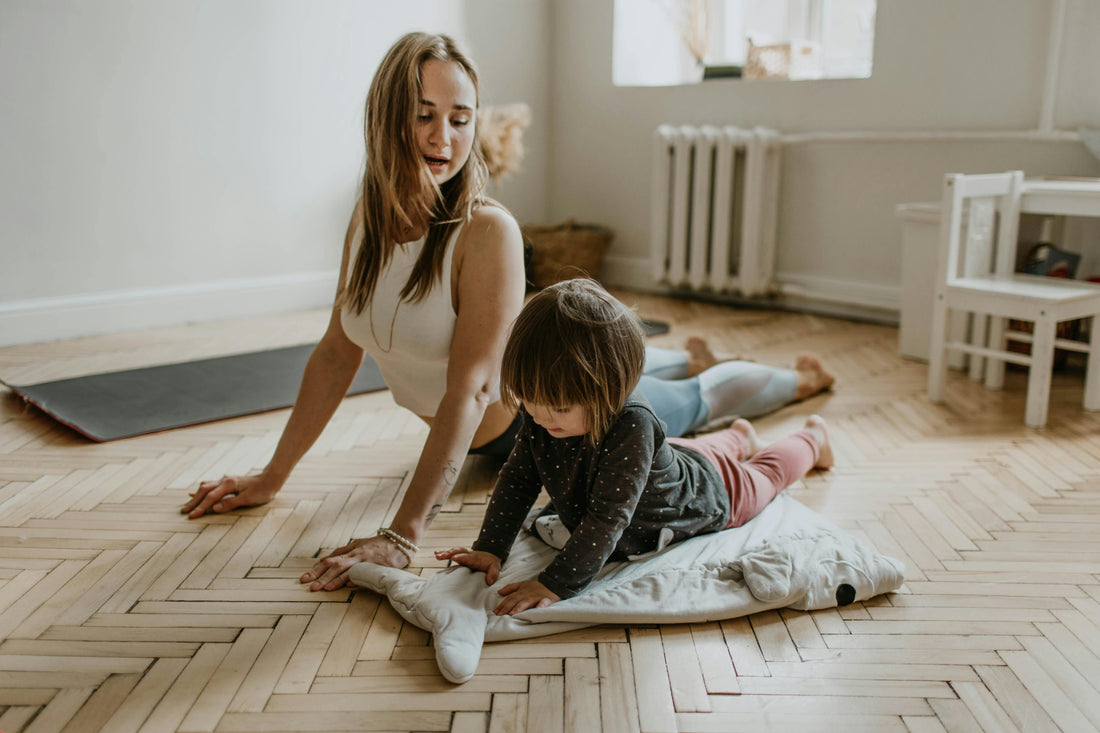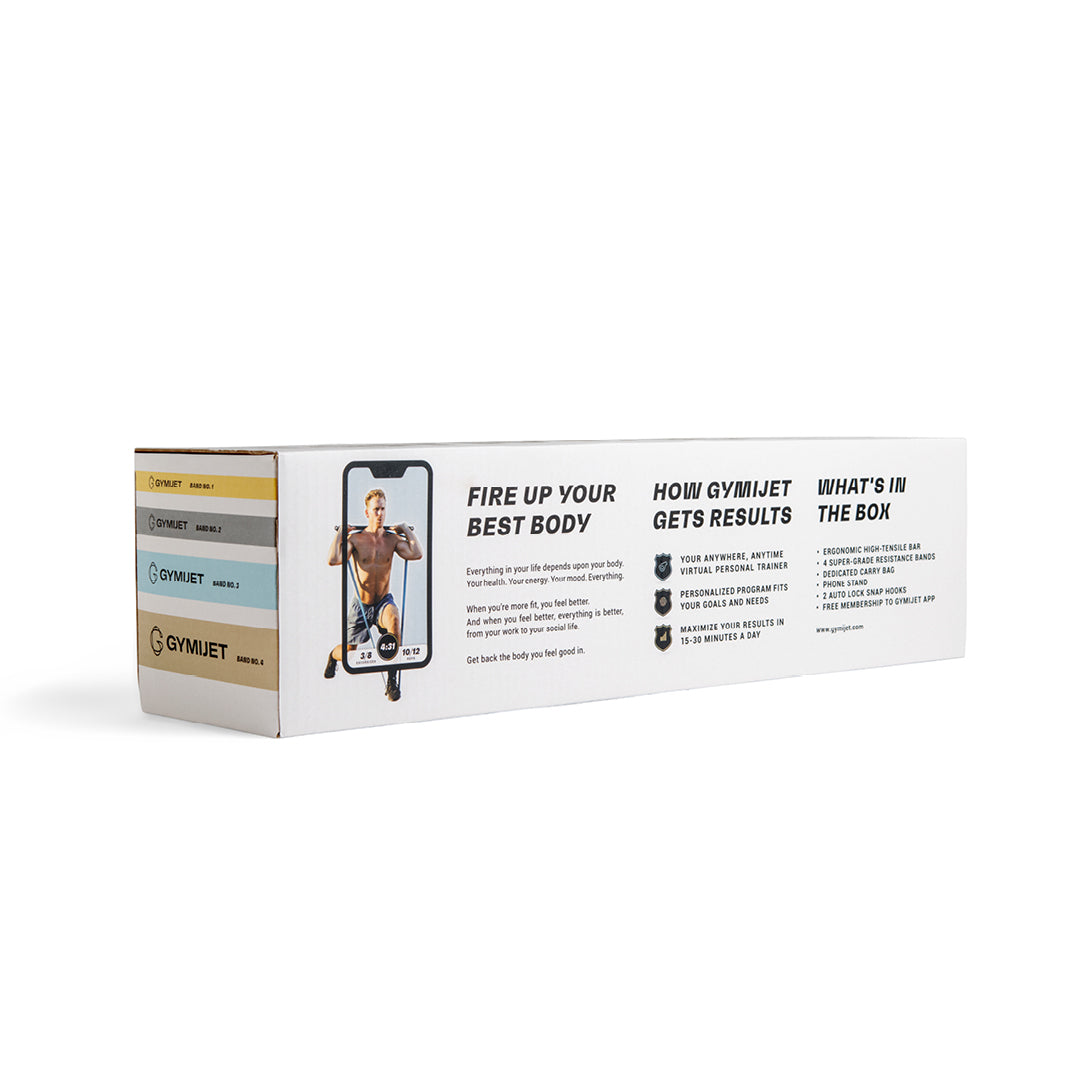
How to Exercise With Kids Around at Home
Share
Imagine this: The alarm goes off at 5 AM for your planned workout, but your toddler had other plans: up three times during the night and now sleeping soundly in your bed. Your baby needs feeding, your preschooler wants breakfast, and that carefully scheduled "me time" has evaporated before the day even began.
But what if the solution isn't finding more time, but finding smarter ways to work with the time and space you already have? The secret lies in reimagining what a workout looks like: transforming exercise from something that requires separation from your children into something that can happen alongside, around, or even with them. With the right strategies and tools, your living room can become a fitness sanctuary that accommodates both your health goals and your children's needs.
The Challenge: Why Traditional Workouts Don't Work for Parents
Constant Interruptions and Unpredictable Schedules
Research from the American Council on Exercise shows that the average parent gets interrupted every 3-4 minutes during attempted home workouts. Children's needs don't pause for push-ups: diaper changes, snack requests, sibling disputes, and sudden emotional meltdowns all compete for immediate attention. Parents must navigate the chaos of unpredictable nap times, meal schedules, and the constant vigilance required to keep small humans safe and happy.
Safety Concerns and Equipment Limitations
Traditional home gym equipment poses significant safety risks to children. Heavy weights can cause serious injury, exercise bikes and treadmills present entrapment hazards, and even yoga mats can become slip-and-fall risks when toddlers decide to use them as slides. A 2023 Consumer Product Safety Commission report found that exercise equipment-related injuries involving children under 8 increased by 32% in home settings, making equipment choice a critical safety consideration for parent fitness.
Guilt and Priority Conflicts
Many parents, especially mothers, struggle with guilt when taking time for personal fitness. The mental load of constantly anticipating children's needs makes it difficult to fully disconnect, even for 20-30 minutes. This psychological barrier often sabotages workout attempts, as parents find themselves half-listening for cries, checking on sleeping babies, or cutting sessions short to attend to their children's immediate needs.
Space and Noise Constraints
Most family homes lack dedicated workout spaces, and parents must consider noise levels that might wake sleeping children or disturb neighbors in apartments. High-intensity jumping exercises, dropping weights, or loud workout videos become impractical when you're trying to maintain the delicate balance of household harmony while caring for young children.
Energy and Recovery Challenges
Sleep deprivation significantly impacts exercise performance and recovery. New parents average 2-3 hours less sleep per night than recommended, affecting hormone regulation, muscle recovery, and motivation. Traditional workout intensities designed for well-rested adults can feel overwhelming and counterproductive for parents operating on limited sleep and constant stress.
Practical Solutions: Creative Strategies for Family-Friendly Fitness
Workout Integration Strategies
Morning Movement Before Kids Wake: Set your alarm 20 minutes earlier and complete a quiet, equipment-free routine. Focus on bodyweight exercises like wall sits, modified planks against the couch, or gentle yoga flows that won't wake sleeping children. Keep movements controlled and avoid jumping or high-impact activities that create noise.
Naptime Power Sessions: Maximize precious naptime with efficient, compound movements that work multiple muscle groups simultaneously. A 15-minute resistance band circuit can provide a full-body workout without equipment setup time. Keep everything ready to go so you can start immediately when the opportunity arises.
Evening Wind-Down Workouts: After bedtime, engage in calming exercises that prepare your body for sleep while maintaining fitness. Gentle strength training with resistance bands, stretching routines, or yoga flows helps release daily tension while building strength and flexibility.
Kid-Inclusive Exercise Ideas
Playground Workouts: Transform playground visits into fitness opportunities. While children play, you can use park benches for step-ups and tricep dips, playground equipment for pull-ups and leg raises, or simply walk/jog laps around the play area. This approach combines childcare supervision with personal fitness time.
Dance Party Workouts: Put on energetic music and dance with your children for 10-15 minutes. This cardiovascular exercise feels like play to kids while providing genuine fitness benefits for adults. Add in jumping jacks, marching in place, or arm circles to increase intensity.
Walking Adventures: Turn daily walks into fitness opportunities by incorporating bodyweight exercises at different stops. Park bench workouts, hill walking for resistance, or simply increasing pace during certain segments can transform routine outings into effective exercise sessions.
Baby-Wearing Workouts: For parents with infants, baby carriers allow hands-free movement during exercises like squats, lunges, or walking. The added weight increases workout intensity while keeping the baby close and content. Always ensure proper carrier fit and avoid exercises that could compromise balance or the baby's safety.
Time Management Hacks
The 15-Minute Rule: Commit to just 15 minutes of movement daily. Research shows that even short exercise bursts provide significant health benefits, and the psychological win of consistency often naturally leads to longer sessions when time permits.
Exercise Snacking: Break workouts into 2-3 minute "snacks" throughout the day. Two minutes of squats while coffee brews, a minute of wall push-ups while dinner cooks, or calf raises while folding laundry. These micro-sessions accumulate significant weekly exercise volume.
Priority Movement Patterns: Focus on exercises that address the physical demands of parenting, such as strengthening your back and core for lifting children, improving posture from constant carrying, and maintaining hip flexibility from extended sitting during feeding times.
How Gymijet Solves This Problem
Silent, Compact Equipment Perfect for Family Homes
The Gymijet portable home gym kit weighs only 6 pounds and stores in a compact bag smaller than a diaper bag. Unlike clanging weights or noisy machines, resistance bands provide completely silent operation that won't wake sleeping babies or disturb playing children. Set up anywhere in your home in seconds, complete your workout, and store everything away before your children even notice you exercised.
AI-Guided Safety and Form Correction
The Gymijet fitness app uses AI technology to monitor your exercise technique and alert you when your form needs attention, ensuring you stay safe even when distracted by children's needs. When your toddler interrupts mid-exercise, the app pauses and resumes seamlessly, maintaining workout continuity despite constant interruptions.
Quick Setup and Flexible Timing
Gymijet eliminates the setup time that often prevents busy parents from exercising. No assembling equipment, no clearing large spaces, no complicated routines. The resistance bands attach to doors, furniture, or your own body, allowing workouts in living rooms, bedrooms, or even outdoors while children play. This flexibility means you can exercise during unpredictable windows of opportunity without lengthy preparation.
Progressive Resistance for Recovering Bodies
Many parents, especially new mothers, need gradual strength progression as their bodies recover from pregnancy and adapt to the physical demands of childcare. Gymijet's variable resistance system grows with your recovery and fitness level, providing gentle resistance for early postpartum exercise that progresses to challenging strength training as your capacity improves.
Parent-Friendly Workout Length Options
The app offers workout lengths from 5 to 45 minutes, recognizing that parent schedules require maximum flexibility. Whether you have 5 minutes while your baby naps or 20 minutes during screen time, there's an appropriate routine available. The AI learns your typical available time slots and suggests workouts that fit your realistic schedule, not an idealized fitness fantasy.
Expert Tips: Professional Insights for Parent Fitness
- Prioritize Family Involvement Over Perfect Routines - Pediatric exercise physiologist Dr. Avery Faigenbaum from The College of New Jersey emphasizes that "Remember the five F-words of youth fitness: fun, family, fitness, feelings, and flourish." His 250+ peer-reviewed publications demonstrate that family support is critical for children's fitness success, and establishing good fitness habits during childhood with family involvement "sets people up for decades of success."
- Address the Guilt Factor Head-On - Dr. Emily Mailey's research at Kansas State University found that working parents, especially mothers, face significant guilt about taking time for exercise. Her studies show that successful parent exercisers make it clear "they were not exercising at the expense of time with their children" and develop specific strategies like "waking up early to exercise, rearranging work schedules, and planning to be active during children's activities."
- Model Physical Activity for Long-Term Impact - Dr. Ryan Rhodes from the University of Victoria conducted a comprehensive meta-analysis research showing that "parental behaviors (i.e., modeling and support) represent an obvious important factor in child PA." His research found that parental modeling was associated with child physical activity, while parental support showed even stronger associations with children's activity levels.
- Take a Whole Family Approach to Wellness - Dr. Nick Fuller from the University of Sydney, author of "Healthy Parents, Healthy Kids: Six Steps to Total Family Wellness," emphasizes that "providing your kids with the best start in life begins with you." His research-based approach recognizes that parent wellness is foundational to family health, advocating for practical lifestyle plans that accommodate time and energy constraints.
- Focus on Functional Movement Patterns - Dr. Sarah Ellis Duvall, DPT from Core Exercise Solutions, emphasizes that postpartum and parent fitness should focus on "breathing mechanics as the foundation for core recovery, pelvic floor rehabilitation, and returning to higher-intensity functional activities that parents need for daily life."
FAQs
Is it safe to exercise with my baby or toddler around?
Yes, with proper precautions. Choose exercises that maintain your balance and awareness, avoid movements that could result in falling, and ensure your exercise space is child-proofed. Resistance bands are particularly safe as they don't involve heavy weights or equipment that could injure children if they get too close.
How can I stay motivated when my workouts keep getting interrupted?
Reframe interruptions as part of your workout rather than obstacles to it. Expect them, plan for them, and celebrate partial workouts as victories. Even 5-10 minutes of movement provides health benefits, and consistency with shorter sessions often yields better long-term results than sporadic, longer workouts.
What if my children want to exercise with me?
Embrace it! Children naturally love to move and copy their parents. Create simple movements they can do alongside you, such as marching in place, arm circles, or gentle stretching. This teaches them healthy habits while solving your childcare challenge during exercise time.
When is the best time to exercise as a parent?
The best time is whenever you can do it consistently. Some parents prefer early mornings before children wake, others use naptime, and some exercise after bedtime. Experiment with different times to find what works best for your family's schedule and your energy levels.
How do I exercise when I'm sleep-deprived and exhausted?
Begin with gentle activities like walking or stretching instead of intense workouts when you're severely sleep-deprived. Exercise can actually boost energy levels, but listen to your body and choose restorative activities when you're running on empty. Even 5 minutes of gentle movement is better than nothing.
Building Fitness Into Family Life: Your Path Forward
Exercising with children around isn't about finding the perfect childcare solution or waiting for life to become less chaotic. It's about reimagining fitness to fit your family's reality. The goal isn't to achieve pre-children workout intensity immediately, but to maintain movement, strength, and wellness while honoring your role as a caregiver.
Your fitness journey as a parent looks different from other people's, and that's perfectly okay. What matters is finding sustainable ways to prioritize your health that work within your family's unique circumstances. With flexible equipment, realistic expectations, and creative strategies, you can model healthy habits for your children while taking care of yourself.
Start Your Family-Friendly Fitness Journey Now and discover how AI-powered, portable fitness solutions can transform your home into a parent-friendly gym that grows with your family's changing needs.














